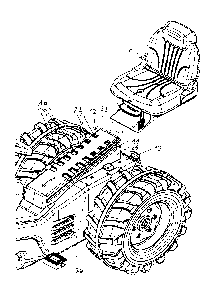Some of the information on this Web page has been provided by external sources. The Government of Canada is not responsible for the accuracy, reliability or currency of the information supplied by external sources. Users wishing to rely upon this information should consult directly with the source of the information. Content provided by external sources is not subject to official languages, privacy and accessibility requirements.
Any discrepancies in the text and image of the Claims and Abstract are due to differing posting times. Text of the Claims and Abstract are posted:
| (12) Patent: | (11) CA 2943509 |
|---|---|
| (54) English Title: | CHILDREN'S VEHICLE |
| (54) French Title: | VEHICULE D'ENFANT |
| Status: | Granted and Issued |
| (51) International Patent Classification (IPC): |
|
|---|---|
| (72) Inventors : |
|
| (73) Owners : |
|
| (71) Applicants : |
|
| (74) Agent: | MCKAY-CAREY & COMPANY |
| (74) Associate agent: | |
| (45) Issued: | 2022-09-06 |
| (22) Filed Date: | 2016-09-29 |
| (41) Open to Public Inspection: | 2017-07-21 |
| Examination requested: | 2021-02-11 |
| Availability of licence: | N/A |
| Dedicated to the Public: | N/A |
| (25) Language of filing: | English |
| Patent Cooperation Treaty (PCT): | No |
|---|
| (30) Application Priority Data: | ||||||
|---|---|---|---|---|---|---|
|
The children's vehicle with a seat is characterised by an adjustable locking device, with which a desired position of the seat in the longitudinal direction of the children's vehicle may be set, and a security locking device, which only releases the adjustable locking device for adjustment of the current position when the seat is unloaded.
Le véhicule pour enfant avec un siège est caractérisé par un dispositif de verrouillage ajustable, par lequel une position souhaitée du siège dans le sens longitudinal du véhicule peut être réglée, et un dispositif de verrouillage de sécurité, qui libère seulement le dispositif de verrouillage ajustable pour lajustement de la position actuelle lorsque le siège est déchargé.
Note: Claims are shown in the official language in which they were submitted.
Note: Descriptions are shown in the official language in which they were submitted.

2024-08-01:As part of the Next Generation Patents (NGP) transition, the Canadian Patents Database (CPD) now contains a more detailed Event History, which replicates the Event Log of our new back-office solution.
Please note that "Inactive:" events refers to events no longer in use in our new back-office solution.
For a clearer understanding of the status of the application/patent presented on this page, the site Disclaimer , as well as the definitions for Patent , Event History , Maintenance Fee and Payment History should be consulted.
| Description | Date |
|---|---|
| Maintenance Request Received | 2024-08-08 |
| Maintenance Fee Payment Determined Compliant | 2024-08-08 |
| Inactive: Grant downloaded | 2022-09-21 |
| Inactive: Grant downloaded | 2022-09-21 |
| Inactive: Grant downloaded | 2022-09-21 |
| Grant by Issuance | 2022-09-06 |
| Letter Sent | 2022-09-06 |
| Inactive: Cover page published | 2022-09-05 |
| Pre-grant | 2022-06-27 |
| Inactive: Final fee received | 2022-06-27 |
| Letter Sent | 2022-05-24 |
| Notice of Allowance is Issued | 2022-05-24 |
| Notice of Allowance is Issued | 2022-05-24 |
| Inactive: Approved for allowance (AFA) | 2022-04-08 |
| Inactive: Q2 passed | 2022-04-08 |
| Letter Sent | 2021-02-19 |
| Request for Examination Received | 2021-02-11 |
| All Requirements for Examination Determined Compliant | 2021-02-11 |
| Request for Examination Requirements Determined Compliant | 2021-02-11 |
| Common Representative Appointed | 2020-11-07 |
| Common Representative Appointed | 2019-10-30 |
| Common Representative Appointed | 2019-10-30 |
| Application Published (Open to Public Inspection) | 2017-07-21 |
| Inactive: Cover page published | 2017-07-20 |
| Inactive: Reply to s.37 Rules - Non-PCT | 2016-12-12 |
| Inactive: IPC assigned | 2016-11-30 |
| Inactive: IPC assigned | 2016-11-30 |
| Inactive: First IPC assigned | 2016-11-30 |
| Inactive: Filing certificate - No RFE (bilingual) | 2016-10-06 |
| Filing Requirements Determined Compliant | 2016-10-06 |
| Application Received - Regular National | 2016-09-30 |
There is no abandonment history.
The last payment was received on 2021-09-24
Note : If the full payment has not been received on or before the date indicated, a further fee may be required which may be one of the following
Please refer to the CIPO Patent Fees web page to see all current fee amounts.
| Fee Type | Anniversary Year | Due Date | Paid Date |
|---|---|---|---|
| Application fee - standard | 2016-09-29 | ||
| MF (application, 2nd anniv.) - standard | 02 | 2018-10-01 | 2018-09-18 |
| MF (application, 3rd anniv.) - standard | 03 | 2019-09-30 | 2019-07-30 |
| MF (application, 4th anniv.) - standard | 04 | 2020-09-29 | 2020-09-25 |
| Request for examination - standard | 2021-09-29 | 2021-02-11 | |
| MF (application, 5th anniv.) - standard | 05 | 2021-09-29 | 2021-09-24 |
| Final fee - standard | 2022-09-26 | 2022-06-27 | |
| MF (patent, 6th anniv.) - standard | 2022-09-29 | 2022-09-26 | |
| MF (patent, 7th anniv.) - standard | 2023-09-29 | 2023-07-19 | |
| MF (patent, 8th anniv.) - standard | 2024-10-01 | 2024-08-08 |
Note: Records showing the ownership history in alphabetical order.
| Current Owners on Record |
|---|
| FRANZ SCHNEIDER GMBH & CO. KG |
| Past Owners on Record |
|---|
| LUTHER RAINER |